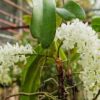# Understanding Common Diseases in Da Châu Orchids and Prevention Strategies

Da Châu orchids (*Dendrobium chaochowense*) are known for their stunning beauty and vibrant colors, making them a popular choice among plant enthusiasts. However, like all plants, they are susceptible to various diseases that can affect their health and appearance. Understanding these common diseases and implementing preventive measures is crucial for maintaining the vitality of your Da Châu orchids. This comprehensive guide will explore the most common diseases affecting Da Châu orchids, their symptoms, causes, and effective prevention strategies.
## Overview of Da Châu Orchids
### Botanical Characteristics
Da Châu orchids are a part of the *Dendrobium* genus, which comprises numerous species that are native to tropical regions. Here are some key characteristics of Da Châu orchids:
– **Flowers**: These orchids are known for their beautiful clusters of flowers that can range from white to shades of pink, purple, and yellow. The blooms can last for several weeks, providing a stunning visual display.
– **Growth Habit**: Da Châu orchids have an upright growth habit with long stems that can reach up to 3 feet (about 1 meter). They thrive in various conditions but require proper care to maintain their beauty.
– **Cultural Importance**: In many cultures, orchids symbolize love, beauty, and strength. They are often given as gifts for special occasions, making their care and preservation essential.
## Common Diseases Affecting Da Châu Orchids
Despite their resilience, Da Châu orchids can be affected by several diseases, primarily caused by environmental factors, pests, or improper care. Below are some of the most common diseases encountered by orchid growers:
### 1. Root Rot
#### Symptoms
Root rot is one of the most common diseases affecting Da Châu orchids. Symptoms include:
– Yellowing or wilting leaves
– Mushy or blackened roots
– A foul odor emanating from the potting medium
– Stunted growth or overall decline in health
#### Causes
Root rot is primarily caused by overwatering, which leads to waterlogged conditions in the potting medium. Poor drainage, high humidity, and lack of airflow around the roots can exacerbate this problem.
#### Prevention
To prevent root rot, consider the following strategies:
– **Proper Watering**: Water your orchids only when the top inch of the potting medium feels dry. This prevents excess moisture from accumulating.
– **Well-Draining Medium**: Use a well-draining potting medium, such as a mix of bark, coconut coir, and perlite. This allows excess water to escape and promotes healthy root development.
– **Adequate Drainage**: Ensure that your pots have sufficient drainage holes to prevent water from sitting at the bottom.
– **Air Circulation**: Maintain good airflow around the plant to help evaporate excess moisture and reduce humidity levels.
### 2. Fungal Infections
#### Symptoms
Fungal infections can manifest in various ways, including:
– Leaf spots or patches
– Powdery mildew on leaves
– Black or brown lesions on stems
– Wilting or drooping flowers
#### Causes
Fungal infections are often caused by high humidity, poor air circulation, and overcrowding of plants. They can also occur due to overwatering and damp conditions.
#### Prevention
Preventing fungal infections involves creating an environment that is less conducive to fungal growth:
– **Humidity Control**: While orchids thrive in humid conditions, excessively high humidity can promote fungal infections. Aim for a humidity level of around 50% to 70%.
– **Good Airflow**: Ensure adequate air circulation around your orchids. Avoid placing them too close to other plants to prevent overcrowding.
– **Proper Watering Practices**: Water in the morning to allow excess moisture to evaporate throughout the day. Avoid wetting the leaves when watering, as this can promote fungal growth.
– **Fungicide Treatment**: If you notice any signs of fungal infection, apply an appropriate fungicide to affected areas as soon as possible.
### 3. Bacterial Soft Rot
#### Symptoms
Bacterial soft rot primarily affects the leaves and stems of Da Châu orchids. Symptoms include:
– Soft, mushy spots on leaves and stems
– Discoloration, often turning dark or brown
– A foul odor from the affected areas
– Rapid wilting of leaves
#### Causes
Bacterial soft rot is often caused by high humidity, overwatering, and poor drainage. It can also occur if the plant is injured, allowing bacteria to enter.
#### Prevention
To prevent bacterial soft rot, follow these guidelines:
– **Careful Handling**: Avoid damaging the plant during handling or pruning. Use sterilized tools to minimize the risk of introducing bacteria.
– **Water Management**: Water the orchids only when necessary, ensuring the potting medium dries out between waterings.
– **Remove Affected Parts**: If you notice any signs of bacterial soft rot, remove the affected parts immediately to prevent the spread of the infection.
– **Maintain Airflow**: Ensure good airflow around the plants to help keep leaves dry and reduce humidity levels.
### 4. Aphid Infestation
#### Symptoms
Aphids are small insects that can cause significant damage to Da Châu orchids. Symptoms of aphid infestation include:
– Curling or distorted leaves
– Yellowing leaves
– Sticky residue (honeydew) on leaves and surrounding surfaces
– Presence of black sooty mold on leaves
#### Causes
Aphids are attracted to the sap of the orchids, leading to damage and potential disease transmission.
#### Prevention
Preventing aphid infestations involves a combination of good cultural practices and pest management:
– **Regular Inspection**: Check your orchids regularly for signs of aphids or other pests. Early detection is key to managing infestations.
– **Companion Planting**: Introduce beneficial insects, such as ladybugs or lacewings, that feed on aphids, helping to control their population.
– **Neem Oil Treatment**: If aphids are detected, treat the affected plants with neem oil or insecticidal soap to eliminate them.
– **Healthy Environment**: Maintain a healthy growing environment by ensuring proper watering, fertilization, and air circulation to reduce stress on the plants.
### 5. Spider Mite Infestation
#### Symptoms
Spider mites are tiny pests that can cause significant damage to Da Châu orchids. Symptoms include:
– Fine webbing on leaves and stems
– Yellow or stippled leaves
– Premature leaf drop
– Weak and unhealthy plants
#### Causes
Spider mites thrive in dry, hot conditions and can multiply quickly, making them a common pest problem.
#### Prevention
To prevent spider mite infestations, consider the following strategies:
– **Increase Humidity**: Since spider mites thrive in dry conditions, increasing humidity levels can deter their presence. Consider using a humidifier or placing a tray of water near your orchids.
– **Regular Misting**: Lightly mist the leaves of your orchids regularly to create a less favorable environment for spider mites.
– **Inspect for Damage**: Regularly check for signs of spider mites and treat any affected plants immediately with insecticidal soap or miticides.
– **Keep Plants Clean**: Wipe the leaves of your orchids with a damp cloth to remove dust and potential pests.
### 6. Powdery Mildew
#### Symptoms
Powdery mildew is a fungal disease that appears as a white, powdery coating on leaves and stems. Symptoms include:
– White powdery spots on leaves and stems
– Stunted growth
– Leaf yellowing and premature drop
#### Causes
Powdery mildew thrives in high humidity and poor air circulation, often occurring during warm, dry weather.
#### Prevention
Preventing powdery mildew involves maintaining a suitable growing environment:
– **Good Air Circulation**: Ensure adequate air movement around your orchids by spacing them properly and using fans if necessary.
– **Watering Practices**: Water the plants in the morning to allow moisture to evaporate during the day.
– **Fungicide Treatment**: If powdery mildew appears, apply a fungicide specifically designed for powdery mildew to affected areas.
## General Prevention Strategies for Orchid Health
Maintaining the overall health of your Da Châu orchids is essential for preventing disease. Here are some general prevention strategies to consider:
### 1. Proper Watering Techniques
– Water your orchids only when needed, allowing the potting medium to dry out between waterings.
– Use distilled or rainwater to avoid chemicals present in tap water that can harm orchids.
### 2. Ideal Growing Conditions
– Maintain appropriate temperature and humidity levels for Da Châu orchids, typically between 65°F to 75°F (18°C to 24°C) and 50% to 70% humidity.
– Avoid placing orchids near drafts, heating vents, or air conditioning units, as rapid temperature changes can stress the plants.
### 3. Fertilization Practices
– Use a balanced orchid fertilizer during the growing season (spring and summer) to provide essential nutrients.
– Follow the manufacturer’s recommendations for dilution rates and application frequency.
### 4. Regular Maintenance
– Inspect your orchids regularly for signs of pests or diseases and address any issues promptly.
– Prune away dead or yellowing leaves and spent flower spikes to promote healthy growth.
### 5. Clean Growing Environment
– Keep the growing area clean and free from debris, which can harbor pests and diseases.
– Disinfect pots and tools regularly to minimize the risk of disease transmission.
### 6. Quarantine New Plants
– When introducing new orchids to your collection, quarantine them for a few weeks to ensure they are free from pests and diseases before mixing them with your existing plants.
## Conclusion
Understanding the common diseases that affect Da Châu orchids and implementing effective prevention strategies is essential for maintaining their health and beauty. By providing the right growing conditions, practicing good watering and fertilization techniques, and staying vigilant against pests and diseases,
you can cultivate thriving Da Châu orchids that will reward you with stunning blooms for years to come. Remember that prevention is always easier than treatment, so prioritize the overall health of your orchids to enjoy their beauty without the worry of disease.

